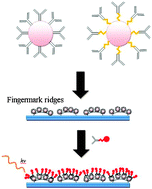In what could prove to be a landmark development in forensic science to both law enforcement and for the Innocence Project, we want to present to you the recent work of Dr Xanthe Spindler of University Technology Sydney. She has published that she has developed a new method of developing what heretofore would be undiscovered and non-discoverable fingerprints.
Now we have written on fingerprints before:
- Are fingerprints worthwhile?
- Unused technology: Fingerprints off Brass Shell Casings due to corrosion
- Also it was featured in our Winner of the Week 27 www.TheTruthAboutForensicScience.com Forensic Science Geek of the Week Challenge!!!
If validated and further research verifies Dr. Spindler’s claims, we will have a new method fingerprints.

- Latent fingermarks from a male donor developed on aluminium foil. Image provided by Xanthe Spindler
Recently published in Chemical Communications (“Enhancement of latent fingermarks on non-porous surfaces using anti-L-amino acid antibodies conjugated to gold nanoparticles”), a journal of the Royal Society of Chemistry, the work is also a step in pursuit of the “Holy Grail” as Dr Spindler calls it, a reliable method for recovering fingerprints from human skin.
The new method developed by Dr Spindler as part of her PhD work uses antibodies designed to target amino acids and can detect aged, dry and weak fingerprints that cannot be captured using traditional fingerprinting methods.
We’ve been able to successfully target amino acids on non-porous surfaces for the first time, with promising results in enhancing aged and degraded fingermarks that typically give poor results with traditional powdering and cyanoacrylate fuming. The potential is there to go back to old cases to see what might now be recovered.
Dr Spindler.
- How the basic technology works
From the abstract:
Enantioselective anti-L-amino acid antibodies conjugated to gold nanoparticles are shown to facilitate the detection of latent fingermarks by interacting with amino acids present in friction ridge secretions. This antibody-based system is particularly effective for the enhancement of aged and dried fingermarks on non-porous surfaces, an area unexploited by current techniques.



